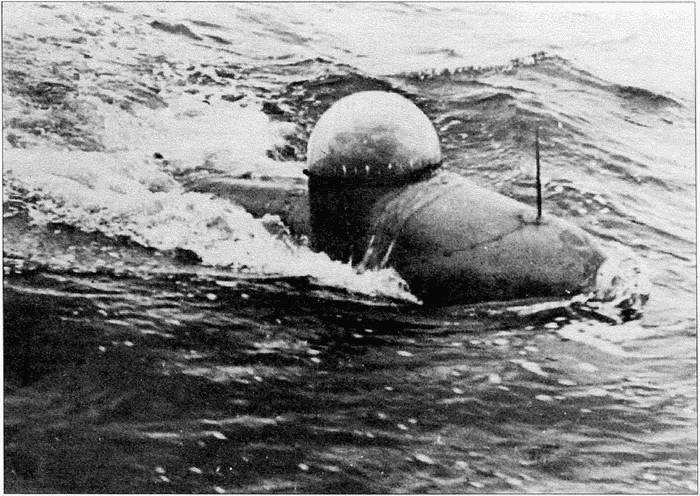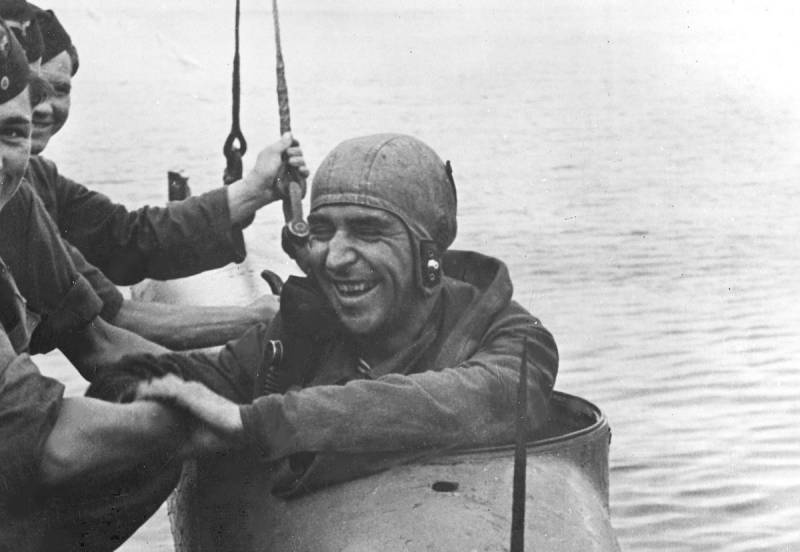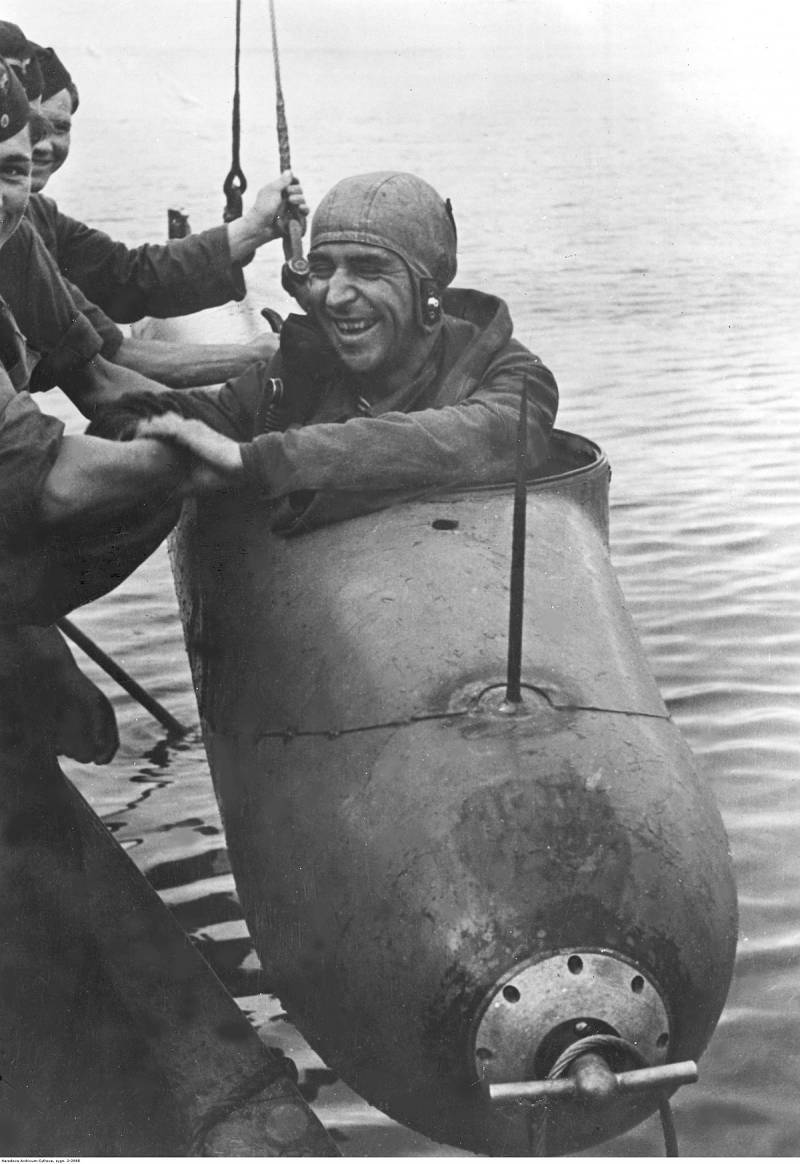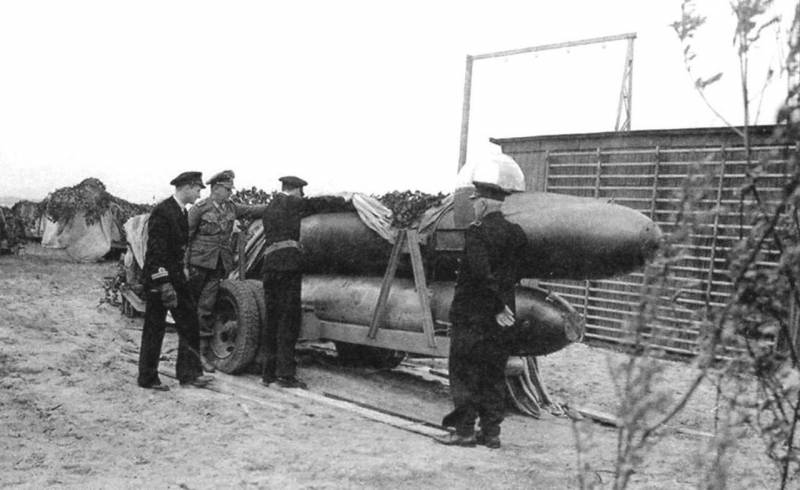Kriegsmarine Combat Swimmers: Compound "K"
The topic of sea saboteurs is one of the most interesting in stories World War II. It, perhaps, can be called little-studied and forgotten: the actions of small combat groups are lost against the backdrop of epoch-making battles tank armies and breathtaking sea battles.
When it comes to combat swimmers, everyone, of course, vaguely remembers something about the legendary Italian 10th flotilla MAC. And then, however, more often in the context of conspiracy theories associated with the death of the battleship "Novorossiysk". Some have heard something remotely about Japanese manned kamikaze torpedoes. But as for all the other countries participating in the war - here we can meet only a silent misunderstanding.
World War II was the prelude to the massive training of special forces - and Germany was by no means an exception to this. The military leadership of the Third Reich, paralyzed by the total superiority of the allied forces, both at sea and in the air, was forced to begin to develop an asymmetric response - and such were the teams of naval saboteurs ...
In industrial circles, I met with full understanding and support, due, in particular, to the sober consideration that the old direction in shipbuilding can no longer bring success in war.
Our intentions at the first stage were as follows:
1. To develop and build special baby submarines according to English models and train crews; use these baby boats to perform special tasks, for example, to infiltrate enemy ports, etc.
2. To carry out special combat training of naval assault detachments (strike groups) - also according to the British model. The purpose of the training is to ensure that small surface vessels and baby submarines conduct attacks on enemy coastal areas and important military facilities located there (radar stations, positions of artillery guns, etc.) ",
- from the personal notes of Vice Admiral Helmut Geye, commander of the "K" formation.
Training and selection of recruits
For quite a long time, the leadership of the Kriegsmarine rejected any projects related to the use of sabotage means in a naval war. However, by the 43rd year, Germany had no choice: it was obvious that the old strategy had outlived itself, there were no resources for building a fleet (as well as technical capabilities - the British regularly bombarded German shipyards with bombs), and the threat of amphibious operations in the European the coast was obvious to absolutely everyone.
Then, following the example of the successful use of combat swimmers in Italy and Great Britain, the Reich decides to create similar units to counter the forces of the Allies.
The search and recruitment of personnel for formation "K" began at the end of 1943. By January 1944, the unit consisted of 30 people - almost all of them were volunteers from various branches of the military.
Here, perhaps, it is worth making some digression.
At that time in Germany, it was extremely difficult to ensure the recruitment of recruits for the elite squad, who would fully and fully meet all the requirements. The war had been going on for several years, and the existing branches of the armed forces were not at all eager to donate their best personnel to the formation of naval special groups. The Kriegsmarine had a monopoly on receiving the most valuable contingents of conscripts - which, however, could not be transferred to the command of the "K" unit on the personal order of Grand Admiral K. Doenitz.
This factor resulted in the fact that most of the volunteers who joined the ranks of the new unit did not have any training and experience for conducting combat operations at sea.
However, despite all the difficulties, Vice Admiral G. Geye managed to select high-quality human material: the recruits had excellent military and sports training, as well as a high level of motivation and fighting spirit. Under his leadership, a special commission was formed, which visited schools and colleges for non-commissioned officers and candidates for officers, identified capable athletes and questioned them for voluntary entry into special forces.
The training of German combat swimmers had several phased directions:
1. Infantry and engineering training (special emphasis was placed on the use of instructors-veterans of the Eastern Front).
2. Hand-to-hand and gymnastic training (in particular, training in ju-jitsu, self-defense techniques without weapons and silently neutralizing enemy posts).
3. Course in automotive and radio engineering.
4. Diving business.
5. Linguistic training (special attention was paid to teaching the soldiers' jargon of opponents).
6. Theoretical sabotage training based on the trophy instructions of the British commandos.
Separately, it is worth mentioning the discipline called "nurturing personal initiative" in the official curriculum. During these sessions, volunteers performed non-standard tasks designed to develop non-standard thinking and audacity in the personnel.
So, for example, the trainees carried out training attacks on police posts, military guards, guarded anchorages of ships, patrols of railway troops, etc. exclusion from the ranks of combat swimmers.
Several weeks of such forced preparation instilled in future naval saboteurs a sense of complete self-confidence even in the face of the most delicate situations.
- from the memoirs of Senior Lieutenant Prinzhorn, one of the officers of the "K" formation.
The main infrastructure facilities for the training of combat swimmers were two camps in the Lubeck area - "Steinkoppel" ("Stone area") and "Blaukoppel" ("Blue area"). The headquarters of the compound was located in the small resort town of Timmendorferstrand, which figured under the name "Strandkoppel" ("Onshore section").
By the spring of 1944, the preparation of the first three groups of naval saboteurs, called "naval assault detachments", had been completed.
In addition to the commander, each detachment consisted of 22 more people. Each such tactical unit was nominally equipped with automotive equipment to give them full autonomy and mobility: the detachment had 15 vehicles at its disposal, including 2 amphibious vehicles, 1 auto kitchen and a number of trucks for transporting personnel, technical equipment and ammunition.
Stocks of food and ammunition were given on the basis of six weeks of fully autonomous functioning: the battle groups could exist for a designated time without any supply of supplies. On top of that, each squad had 3 radios.
Development of new naval weapons
Another starting point in the formation of units of German naval saboteurs was the research torpedo test center in Eckernförd: it was there in March 1944 that the prototype of the manned torpedo "Neger", developed by designer Richard Mohr, was tested. This sample of weapons can be called the first serial weapon of the Kriegsmarine combat swimmers - it will also be destined to "open an account" of the "K" formation in the fight against the ships of the allies.

Manned torpedo "Neger" in combat position. Photo source: zonwar.ru
At that moment, the possibilities of using a single man-controlled torpedo undoubtedly looked extremely attractive. Such a weapon was also quite suitable for the program of Grand Admiral Doenitz, the so-called "intensification of the methods of warfare." Germany was forced to switch from offensive to defensive not only on land but also at sea, and desperately needed to overcome the forced stagnation in the actions of its submarines.
The anti-submarine defense and, in particular, the cover of the Allied convoys had reached extremely high efficiency by 1944. The British and Americans have learned to detect and thwart attacks by German submarines in all naval theaters of operations. Even if they did not manage to hit them with conventional and depth charges, the German sailors lost the initiative - in the submerged position their boats were too slow and helpless, because they could not choose the place and time to torpedo enemy ships.
Of course, sometimes luck favored the crews of submarines, but these were no more than isolated actions dictated by a favorable coincidence. A new effective weapon was required, with the help of which it was possible to strike at enemy surface ships - and as such a weapon the choice of the Kriegsmarine fell on the Neger manned torpedoes.
- Grandadmiral Karl Doenitz, commander of the naval forces of the Third Reich.
The design of the "Neger" took place, in essence, in an emergency mode: the manned torpedoes were refined right during the tests at Eckernförd. The tactics of their combat use were also formed there. Almost immediately it was necessary to abandon any undertakings with the use of this weapon on the high seas - in the process of studying the device, it became clear that it was only suitable for destroying ships standing near the coast, in the roadstead or in the port.
The characteristics of the device can be called rather modest: the power reserve of the device was 48 nautical miles, the speed with a load (torpedo) - 3,2 miles per hour, without a load - 4,2 miles per hour.
Structurally, "Neger" was based on the G7e torpedo, the warhead of which was replaced by a cockpit with a plastic dome (on which special marks were applied to act as sighting devices), and one of the batteries - on the breathing apparatus of the "Dräger" company. During the tests, respirators with oxylite cartridges were also added: at the first stages, the pilots constantly suffered from carbon dioxide poisoning - the personnel regularly experienced nausea, headaches, and cases of loss of consciousness were not uncommon.
In less than a month, the devices were fully tested, refined and put into production - at the end of March 1944, a request was received from Berlin for the participation of the Neger flotilla in hostilities. And the newly formed German naval saboteurs went on their first mission. Which, however, we will talk about in the next article ...
Продолжение следует ...



Information